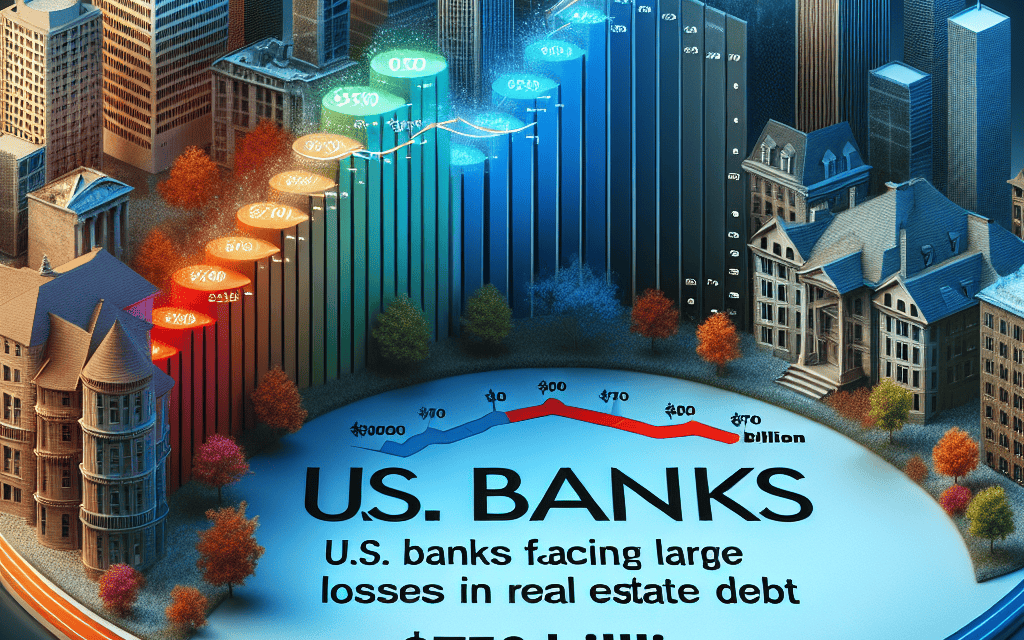“Unveiling the Cracks: Real Estate Debt Threatens U.S. Banks with $750 Billion Losses—Spotlight on Vulnerable Sectors.”
Introduction
U.S. banks are confronting a significant financial challenge as they brace for potential losses amounting to $750 billion in real estate debt. This looming crisis is primarily driven by vulnerabilities across various sectors within the real estate market. As economic conditions fluctuate and interest rates rise, the pressure on commercial and residential real estate loans intensifies, exposing banks to heightened risk. Key sectors such as office spaces, retail properties, and hospitality are particularly susceptible due to changing work patterns, evolving consumer behaviors, and the ongoing impact of the COVID-19 pandemic. Understanding which sectors are most vulnerable is crucial for financial institutions as they navigate this precarious landscape, seeking to mitigate losses and stabilize their portfolios amidst an uncertain economic environment.
Impact Of Rising Interest Rates On U.S. Banks’ Real Estate Portfolios
The U.S. banking sector is currently grappling with significant challenges as it faces potential losses amounting to $750 billion in real estate debt. This alarming figure is primarily attributed to the rising interest rates, which have exerted considerable pressure on banks’ real estate portfolios. As interest rates climb, the cost of borrowing increases, leading to a ripple effect across various sectors of the real estate market. Consequently, banks are now reassessing their exposure to different real estate segments to mitigate potential risks.
To understand the impact of rising interest rates on banks’ real estate portfolios, it is essential to examine the sectors most vulnerable to these changes. Commercial real estate, particularly office spaces, is one of the hardest-hit sectors. The shift towards remote work, accelerated by the COVID-19 pandemic, has led to a decreased demand for office spaces. As companies continue to embrace flexible work arrangements, the vacancy rates in office buildings have surged, resulting in declining property values. This trend poses a significant risk to banks that have heavily invested in commercial real estate loans, as the devaluation of these properties could lead to substantial losses.
In addition to office spaces, the retail sector is also experiencing considerable strain. The rise of e-commerce has fundamentally altered consumer shopping habits, leading to a decline in foot traffic in traditional brick-and-mortar stores. Shopping malls and retail centers, once considered lucrative investments, are now facing increased vacancies and reduced rental income. Banks with significant exposure to retail real estate are consequently at risk of encountering financial difficulties as the value of these properties diminishes.
Moreover, the multifamily housing sector is not immune to the effects of rising interest rates. Although demand for rental properties remains robust, the increased cost of financing has made it more challenging for developers to undertake new projects. This situation has led to a slowdown in the construction of new multifamily units, potentially impacting banks that have extended loans for such developments. Furthermore, higher interest rates can also lead to increased mortgage rates, which may deter potential homebuyers and affect the overall housing market.
While these sectors face significant challenges, it is important to note that not all real estate segments are equally vulnerable. The industrial real estate sector, for instance, has shown resilience amid rising interest rates. The growth of e-commerce and the need for efficient supply chain solutions have driven demand for warehouses and distribution centers. Banks with investments in industrial properties may find some solace in this sector’s continued strength, as it offers a buffer against potential losses in other areas.
In light of these developments, U.S. banks are taking proactive measures to manage their real estate portfolios. Many are reevaluating their lending practices, tightening credit standards, and diversifying their investments to reduce exposure to high-risk sectors. Additionally, banks are increasingly relying on data analytics and market research to make informed decisions about their real estate investments.
In conclusion, the impact of rising interest rates on U.S. banks’ real estate portfolios is profound, with potential losses reaching $750 billion. The commercial office and retail sectors are particularly vulnerable, while the multifamily housing sector also faces challenges. However, the industrial real estate sector offers a glimmer of hope amid these difficulties. As banks navigate this complex landscape, strategic adjustments and prudent risk management will be crucial in safeguarding their financial stability.
Vulnerability Of Commercial Real Estate In The U.S. Banking Sector
The U.S. banking sector is currently grappling with a significant challenge as it faces potential losses amounting to $750 billion in real estate debt. This situation has raised concerns about the vulnerability of various sectors within commercial real estate, prompting a closer examination of which areas are most at risk. As the economic landscape continues to evolve, understanding these vulnerabilities is crucial for stakeholders aiming to mitigate potential financial repercussions.
To begin with, the office space sector stands out as one of the most vulnerable areas within commercial real estate. The COVID-19 pandemic has fundamentally altered the way businesses operate, with remote work becoming a permanent fixture for many companies. Consequently, the demand for traditional office spaces has diminished, leading to increased vacancy rates and declining rental incomes. This shift has placed significant pressure on banks holding office space loans, as the reduced cash flow from these properties heightens the risk of default. Moreover, the uncertainty surrounding the future of work further complicates the outlook for this sector, making it a focal point of concern for financial institutions.
In addition to office spaces, the retail sector is also experiencing substantial challenges. The rise of e-commerce has been a disruptive force, reshaping consumer behavior and reducing foot traffic in brick-and-mortar stores. This trend, exacerbated by the pandemic, has led to a wave of store closures and bankruptcies, particularly among traditional retailers. As a result, shopping malls and retail centers have seen a decline in occupancy rates, impacting their ability to generate consistent rental income. Banks with significant exposure to retail real estate are thus facing increased risks, as the sector’s transformation continues to unfold.
Transitioning to another area of concern, the hospitality sector has been severely impacted by the pandemic, with travel restrictions and reduced consumer spending leading to a sharp decline in occupancy rates for hotels and resorts. Although there has been a gradual recovery in travel and tourism, the sector remains vulnerable to fluctuations in consumer confidence and potential future disruptions. Banks with loans tied to hospitality properties must navigate these uncertainties, as the path to full recovery remains uncertain and contingent on broader economic conditions.
Furthermore, the industrial real estate sector, while generally more resilient, is not entirely immune to vulnerabilities. The surge in demand for logistics and warehousing facilities, driven by the growth of e-commerce, has been a positive development. However, this sector faces challenges related to supply chain disruptions and geopolitical tensions, which could impact its stability. Banks must remain vigilant in assessing the creditworthiness of borrowers within this sector, as any adverse developments could have ripple effects on their loan portfolios.
In conclusion, the U.S. banking sector’s exposure to $750 billion in real estate debt underscores the need for a comprehensive understanding of vulnerabilities within commercial real estate. The office space, retail, hospitality, and industrial sectors each present unique challenges that banks must navigate to mitigate potential losses. As the economic environment continues to evolve, financial institutions must adopt proactive strategies to manage these risks effectively. By doing so, they can better position themselves to weather the uncertainties that lie ahead and safeguard their financial stability in the face of ongoing challenges.
How Office Space Vacancies Contribute To Real Estate Debt Losses
The U.S. banking sector is currently grappling with significant challenges, particularly in the realm of real estate debt. A staggering $750 billion in potential losses looms over financial institutions, with office space vacancies emerging as a critical factor contributing to this precarious situation. As the landscape of work continues to evolve, the demand for traditional office spaces has been fundamentally altered, leading to increased vacancies and, consequently, financial strain on banks heavily invested in commercial real estate.
To understand the gravity of the situation, it is essential to examine the underlying causes of rising office space vacancies. The COVID-19 pandemic acted as a catalyst, accelerating the adoption of remote work and hybrid models. Many companies, having realized the cost-effectiveness and flexibility of these arrangements, have opted to downsize their physical office footprints. This shift has resulted in a surplus of office space, particularly in urban centers where large office buildings once thrived. As a result, landlords are struggling to fill these vacancies, leading to a decline in rental income and, ultimately, the value of these properties.
The impact of these vacancies on real estate debt is profound. Banks, which have traditionally viewed commercial real estate as a stable and lucrative investment, are now facing the harsh reality of declining property values. As office buildings remain unoccupied, their market value diminishes, affecting the collateral that underpins loans. Consequently, banks are forced to reassess the risk associated with their real estate portfolios, leading to potential write-downs and increased loan loss provisions. This scenario is particularly concerning for smaller regional banks, which may have a higher concentration of commercial real estate loans compared to their larger counterparts.
Moreover, the ripple effects of office space vacancies extend beyond the immediate financial implications for banks. The broader economic impact cannot be overlooked, as reduced demand for office space affects a myriad of related industries. Construction companies, for instance, face decreased demand for new office developments, while service providers that cater to office environments, such as cleaning and maintenance companies, experience a decline in business. This interconnectedness underscores the complexity of the issue and highlights the need for a comprehensive approach to address the challenges posed by office space vacancies.
In response to these challenges, banks are exploring various strategies to mitigate potential losses. Some are diversifying their portfolios by investing in other real estate sectors that have shown resilience, such as industrial and multifamily properties. Others are working closely with borrowers to restructure loans and provide temporary relief, thereby avoiding defaults and foreclosures. Additionally, there is a growing emphasis on innovation and adaptation, with banks encouraging landlords to repurpose office spaces for alternative uses, such as residential or mixed-use developments.
In conclusion, the issue of office space vacancies is a significant contributor to the potential $750 billion losses in real estate debt faced by U.S. banks. The shift in work dynamics, accelerated by the pandemic, has fundamentally altered the demand for traditional office spaces, leading to increased vacancies and financial strain on banks. As the sector navigates these challenges, a multifaceted approach that includes diversification, collaboration, and innovation will be crucial in mitigating losses and ensuring long-term stability. The road ahead is fraught with uncertainty, but with strategic foresight and adaptability, the banking sector can weather this storm and emerge more resilient.
The Role Of Retail Sector Decline In U.S. Banks’ Financial Strain

The U.S. banking sector is currently grappling with significant financial challenges, as it faces potential losses amounting to $750 billion in real estate debt. A substantial portion of this strain can be attributed to the decline in the retail sector, which has been undergoing a transformative shift over the past decade. As consumer preferences evolve and e-commerce continues to gain traction, traditional brick-and-mortar retail establishments are experiencing a downturn, leading to a ripple effect on the financial institutions that have heavily invested in this sector.
To understand the impact of the retail sector’s decline on U.S. banks, it is essential to consider the broader context of changing consumer behavior. The rise of online shopping platforms has fundamentally altered how consumers purchase goods, resulting in decreased foot traffic in physical stores. Consequently, many retail businesses have been forced to downsize or close their doors altogether. This trend has led to a significant increase in vacancies within shopping malls and retail centers, which in turn affects the commercial real estate market. Banks that have provided loans to these retail properties are now facing the risk of default, as property owners struggle to maintain occupancy and generate sufficient rental income.
Moreover, the decline in the retail sector has been exacerbated by the COVID-19 pandemic, which accelerated the shift towards online shopping and further diminished the viability of physical retail spaces. During the pandemic, many consumers turned to e-commerce for safety and convenience, a habit that has persisted even as restrictions have eased. This shift has left many retail properties with reduced demand, leading to a devaluation of assets and increased pressure on banks holding these loans.
In addition to the direct impact on commercial real estate loans, the retail sector’s decline also affects banks indirectly through its influence on the broader economy. Retail is a significant employer in the United States, and its contraction has led to job losses and reduced consumer spending power. This economic downturn can lead to a rise in non-performing loans across various sectors, as individuals and businesses alike struggle to meet their financial obligations. Consequently, banks are not only dealing with losses from direct exposure to retail real estate but also facing broader financial strain from the economic ripple effects.
Furthermore, the decline in the retail sector has prompted banks to reassess their risk management strategies and lending practices. Financial institutions are increasingly cautious about extending credit to retail-related ventures, opting instead to diversify their portfolios and focus on sectors with more stable growth prospects. This shift in strategy is crucial for banks to mitigate potential losses and ensure long-term financial stability.
In conclusion, the decline of the retail sector plays a significant role in the financial strain faced by U.S. banks, contributing to the potential $750 billion losses in real estate debt. As consumer preferences continue to evolve and the landscape of retail changes, banks must adapt their strategies to navigate these challenges effectively. By understanding the interconnectedness of the retail sector’s decline and its impact on the broader economy, financial institutions can better position themselves to weather the storm and emerge resilient in the face of adversity.
Residential Real Estate Challenges And Their Effect On Bank Losses
The U.S. banking sector is currently grappling with significant challenges, particularly in the realm of real estate debt. As the economy continues to navigate the complexities of post-pandemic recovery, banks are facing potential losses amounting to $750 billion. A substantial portion of these losses is attributed to the residential real estate sector, which has been under considerable strain due to various economic and market factors. Understanding the vulnerabilities within this sector is crucial for assessing the broader implications for financial institutions.
To begin with, the residential real estate market has experienced a series of fluctuations over the past few years. Initially buoyed by low interest rates and a surge in demand for housing, the market has recently encountered headwinds. Rising interest rates, implemented as a measure to curb inflation, have led to increased mortgage costs, thereby dampening the enthusiasm of potential homebuyers. Consequently, this has resulted in a slowdown in home sales, which in turn affects the liquidity and valuation of residential properties. Banks, heavily invested in mortgage-backed securities and home loans, find themselves exposed to the risk of declining property values and potential defaults.
Moreover, the issue of affordability has become a significant concern. As property prices soared during the pandemic, many potential buyers were priced out of the market. This has led to a decrease in the pool of qualified buyers, further exacerbating the challenges faced by the residential real estate sector. Banks, which rely on a steady stream of mortgage repayments, are now confronted with the possibility of increased delinquencies. The ripple effect of this situation is evident in the tightening of credit conditions, as financial institutions become more cautious in their lending practices to mitigate potential losses.
In addition to these factors, the residential rental market is also experiencing its own set of challenges. The pandemic-induced eviction moratoriums, while providing temporary relief to tenants, have left landlords and, by extension, banks in a precarious position. With the expiration of these moratoriums, there is a looming threat of increased evictions, which could lead to a rise in vacancy rates and a subsequent decline in rental income. This scenario poses a risk to banks that have extended loans to landlords and real estate investors, as the ability of these borrowers to service their debt may be compromised.
Furthermore, the geographic disparities in the real estate market add another layer of complexity. While some regions have seen a robust recovery, others continue to struggle with high unemployment rates and sluggish economic growth. Banks with significant exposure to these underperforming areas are particularly vulnerable to losses. The uneven recovery highlights the importance of geographic diversification in mitigating risk, yet it also underscores the challenges banks face in managing their real estate portfolios.
In conclusion, the residential real estate sector presents a multifaceted challenge for U.S. banks as they navigate potential losses in real estate debt. The interplay of rising interest rates, affordability issues, rental market instability, and geographic disparities creates a complex landscape that requires careful management and strategic foresight. As banks work to address these vulnerabilities, the broader implications for the financial system and the economy at large remain a critical area of focus. The path forward will necessitate a balanced approach, combining prudent risk management with innovative solutions to support both the banking sector and the residential real estate market.
Strategies For U.S. Banks To Mitigate Real Estate Debt Risks
As U.S. banks grapple with the looming threat of $750 billion in potential losses tied to real estate debt, it becomes imperative to explore strategies that can mitigate these risks. The real estate sector, a cornerstone of the American economy, is currently facing unprecedented challenges. Various factors, including fluctuating interest rates, changing consumer behaviors, and the lingering effects of the COVID-19 pandemic, have contributed to this precarious situation. Consequently, banks must adopt a multifaceted approach to navigate these turbulent waters effectively.
To begin with, banks should prioritize a comprehensive assessment of their real estate portfolios. By conducting thorough stress tests and scenario analyses, financial institutions can identify the most vulnerable sectors within their holdings. This proactive approach allows banks to anticipate potential defaults and adjust their strategies accordingly. For instance, the commercial real estate sector, particularly office spaces, has been significantly impacted by the shift towards remote work. As companies continue to embrace flexible work arrangements, the demand for traditional office spaces has diminished, leading to increased vacancy rates and declining property values. By recognizing these trends early, banks can re-evaluate their exposure to such assets and consider diversifying their portfolios to include more resilient sectors.
In addition to portfolio assessment, banks should enhance their risk management frameworks. This involves strengthening credit underwriting standards and closely monitoring borrowers’ financial health. By implementing stricter lending criteria, banks can ensure that they are extending credit to borrowers with robust financial profiles, thereby reducing the likelihood of defaults. Moreover, regular monitoring of borrowers’ financial performance enables banks to detect early warning signs of distress and take corrective actions promptly. This proactive approach not only safeguards the bank’s interests but also supports borrowers in navigating financial challenges.
Furthermore, collaboration with borrowers is crucial in mitigating real estate debt risks. Banks should engage in open dialogues with their clients to understand their unique circumstances and explore mutually beneficial solutions. For instance, restructuring loan terms or offering temporary relief measures can provide borrowers with the necessary breathing room to stabilize their financial positions. By adopting a collaborative approach, banks can foster long-term relationships with their clients while minimizing the risk of defaults.
Another strategy involves leveraging technology to enhance decision-making processes. Advanced data analytics and artificial intelligence can provide banks with valuable insights into market trends and borrower behavior. By harnessing these tools, banks can make informed decisions regarding their real estate investments and lending practices. For example, predictive analytics can help identify emerging risks and opportunities within the real estate market, enabling banks to adjust their strategies proactively.
Lastly, diversification remains a key strategy for mitigating real estate debt risks. By expanding their investment portfolios to include a mix of asset classes and geographic locations, banks can reduce their reliance on any single sector or market. This approach not only spreads risk but also positions banks to capitalize on growth opportunities in other areas. For instance, the industrial real estate sector, driven by the e-commerce boom, has shown resilience and growth potential. By reallocating resources towards such sectors, banks can offset potential losses in more vulnerable areas.
In conclusion, as U.S. banks confront the daunting prospect of $750 billion in real estate debt losses, a strategic and proactive approach is essential. Through comprehensive portfolio assessments, enhanced risk management, borrower collaboration, technological integration, and diversification, banks can effectively mitigate risks and navigate the challenges posed by the evolving real estate landscape. By adopting these strategies, financial institutions can safeguard their interests while contributing to the stability and resilience of the broader economy.
Future Outlook: U.S. Banks And The Real Estate Debt Crisis
The U.S. banking sector is currently grappling with a significant challenge as it faces potential losses amounting to $750 billion in real estate debt. This looming crisis is not only a reflection of the vulnerabilities within the real estate market but also a testament to the intricate relationship between financial institutions and property investments. As banks navigate this precarious landscape, it is crucial to understand which sectors are most susceptible to these financial strains and how they might impact the broader economy.
To begin with, the commercial real estate sector stands out as particularly vulnerable. Over the past few years, commercial properties have experienced fluctuating demand, largely due to shifts in work patterns and consumer behavior. The rise of remote work has led to a decreased need for office spaces, leaving many buildings underutilized and, consequently, less valuable. This decline in demand has resulted in lower rental incomes and increased vacancy rates, putting pressure on property owners who are struggling to meet their debt obligations. As banks have significant exposure to commercial real estate loans, they are at risk of substantial losses if these trends continue.
Moreover, the retail sector within commercial real estate is facing its own set of challenges. The growth of e-commerce has fundamentally altered the retail landscape, leading to a decline in foot traffic for brick-and-mortar stores. Many retailers have been forced to close their doors, leaving shopping centers and malls with vacant spaces that are difficult to fill. This shift has not only affected property values but also the ability of landlords to service their debts, further exacerbating the financial strain on banks with significant retail real estate portfolios.
In addition to commercial real estate, the residential property market is also showing signs of vulnerability. Although the housing market experienced a boom during the pandemic, driven by low interest rates and increased demand for suburban living, recent economic conditions have started to reverse this trend. Rising interest rates, coupled with inflationary pressures, have made homeownership less affordable for many Americans. As a result, there is a growing concern about potential defaults on residential mortgages, which could lead to significant losses for banks heavily invested in this sector.
Furthermore, the hospitality industry, which includes hotels and resorts, is another area of concern. Despite a rebound in travel and tourism, the sector has not fully recovered from the pandemic’s impact. Many hospitality businesses are still grappling with reduced occupancy rates and increased operational costs. Consequently, their ability to meet debt obligations remains uncertain, posing a risk to banks with substantial exposure to hospitality loans.
In light of these challenges, U.S. banks are taking proactive measures to mitigate potential losses. They are reassessing their real estate portfolios, tightening lending standards, and increasing their loan loss provisions. However, the path to stability is fraught with uncertainty, as the real estate market’s recovery is contingent on broader economic factors, including interest rates, employment levels, and consumer confidence.
In conclusion, the $750 billion in potential real estate debt losses presents a formidable challenge for U.S. banks. The commercial, retail, residential, and hospitality sectors are particularly vulnerable, each facing unique pressures that could impact their financial stability. As banks navigate this complex environment, their ability to adapt and respond to these challenges will be crucial in determining the future outlook of the U.S. banking sector and its resilience in the face of a real estate debt crisis.
Q&A
1. **Question:** What is the primary cause of the $750 billion losses faced by U.S. banks in real estate debt?
– **Answer:** The primary cause is the decline in property values and increased default rates in the real estate market.
2. **Question:** Which sector of real estate is most vulnerable to these losses?
– **Answer:** The commercial real estate sector, particularly office spaces, is most vulnerable due to changing work patterns and reduced demand.
3. **Question:** How are retail properties affected in this scenario?
– **Answer:** Retail properties are also vulnerable due to the rise of e-commerce and changing consumer behaviors, leading to decreased foot traffic and store closures.
4. **Question:** What impact does the residential real estate sector face?
– **Answer:** The residential sector faces challenges from rising interest rates and affordability issues, which can lead to decreased demand and potential defaults.
5. **Question:** How do rising interest rates contribute to the losses in real estate debt?
– **Answer:** Rising interest rates increase borrowing costs, reduce property values, and can lead to higher default rates as property owners struggle to refinance or sell.
6. **Question:** What role do regional banks play in this situation?
– **Answer:** Regional banks are particularly exposed as they often have significant portions of their loan portfolios tied to local real estate markets, making them more susceptible to localized downturns.
7. **Question:** What measures can banks take to mitigate these losses?
– **Answer:** Banks can mitigate losses by diversifying their loan portfolios, increasing loan loss reserves, and tightening lending standards to reduce exposure to high-risk real estate sectors.
Conclusion
The U.S. banking sector is facing significant challenges with an estimated $750 billion in potential losses tied to real estate debt. The most vulnerable sectors include commercial real estate, particularly office spaces, retail properties, and hospitality, which have been severely impacted by changing work patterns, e-commerce growth, and fluctuating travel demand. These sectors are experiencing declining property values and increased vacancy rates, leading to heightened default risks. Banks with high exposure to these areas may face substantial financial strain, necessitating strategic adjustments and risk management to mitigate potential losses.





